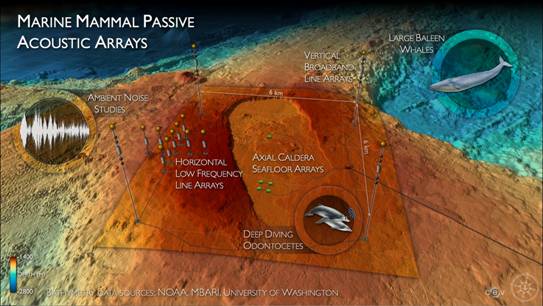
Brandon Southall – Brandon.Southall@sea-inc.net
SEA, Inc & University of California, Santa Cruz
9099 Soquel Drive, Suite 8
Aptos, CA 95003
Christopher Clark – Cornell University
Kendra Daly – University of South Florida
Sue Moore – National Oceanic and Atmospheric Administration
John Payne – Applied Physics Laboratory , University of Washington
Roger Payne – Ocean Alliance Network
Kate Stafford – Applied Physics Laboratory, University of Washington
Mark Stoermer – University of Washington
Peter Tyack – Woods Hole Oceanographic Institution
William Wilcock – University of Washington
John Delaney – University of Washington
Popular version of paper 1aAO “Acoustic Monitoring of Marine Life With Fiber-Optic, Ocean Observing Network”
Presented Monday morning, May 23, 2011
161st ASA Meeting, Seattle, Wash.
Most marine animals use sounds to stay alive – they listen to the world around them to find food, find their way around, evade predators, and keep track of one another to mate and raise their young. Underwater, sound is a primary, if not the principle, way of locating and imaging things, much as light is in air. There is a tremendous amount we can learn about the ocean and its life by using sound. We can simply hear what’s out there, which amazingly we don’t always know. We can monitor how animals and conditions may change with the seasons or changing conditions associated with climate change. We can develop a better understanding of how natural processes like waves, earthquakes, and storms change the underwater soundscape and how animals use it. And we can measure the sound from our own activities and how they can affect the sound-centric animals that live in the sea.
As our abilities to listen to the ocean in trying to better understand and manage it have evolved, the application of fiber-optic, high-bandwidth transmission technology is revolutionizing ocean observing. These advanced systems, stemming from developments in telecommunications, enable the simultaneous acquisition and transmission of high-density data streams, including acoustic measurements. A multi-disciplinary collaboration of geophysicists, acousticians, and biologists is working to merge acoustic observation systems into a cabled observing network that is being deployed off Washington and Oregon and will operate for the next 25 years. This system will include various sensors, including echosounders to detect zooplankton and fish, broadband hydrophone (underwater microphone) clusters for detecting various marine animals in biologically relevant areas, and low-frequency listening capabilities to locate and track vocalizing baleen whales across the Juan de Fuca plate region.

These monitoring capabilities will enable monitoring of acoustically active marine organisms engaged in feeding, migrating, socializing, and other aspects of natural history. In combination with other tools (e.g., animal tags, remote sensors) these rich data streams will be integrated to monitor ecosystems and the physical and biological forces driving their composition. The use of this powerful cabled monitoring network to synoptically observe and acoustically monitor marine life provides an unprecedented opportunity to systematically study the influences of human activities and variability in the natural environment (such as climate) on marine life. It also demonstrates the immense benefits for understanding the ocean with emerging technologies and cross-disciplinary collaboration. Finally, the opportunities for public awareness, engagement, and excitement about the ocean and ocean science afforded by access to near-real time sounds from animals, earthquakes, ships, and other sources by such a system are both remarkable and timely.
OVERARCHING QUESTIONS

SPECIFIC SYSTEM OBJECTIVES

RELATED WEBLINKS
http://www.interactiveoceans.washington.edu/
www.listenforwhales.com
www.dosits.org
http://www.ted.com/talks/peter_tyack_the_intriguing_sound_of_marine_mammals.html
http://www.ted.com/talks/john_delaney_wiring_an_interactive_ocean.html